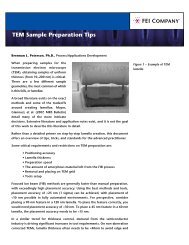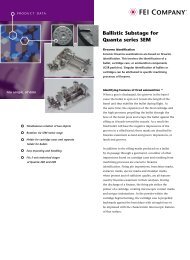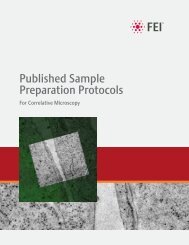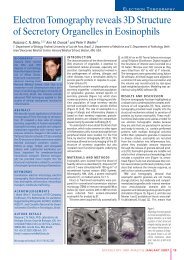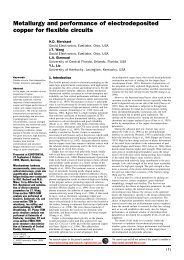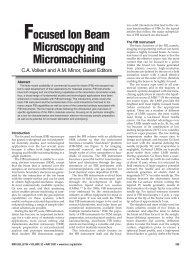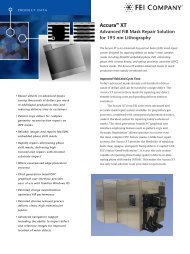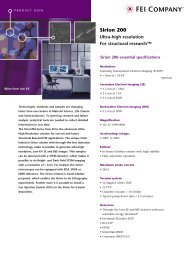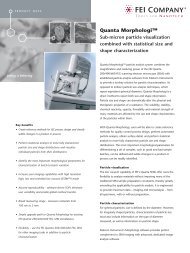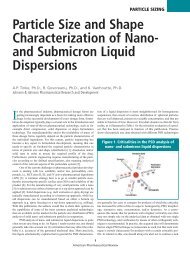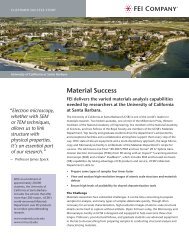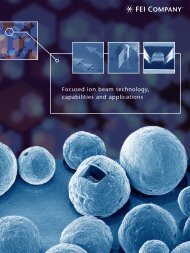Wet STEM: A newdevelopment in environmental SEM for imaging ...
Wet STEM: A newdevelopment in environmental SEM for imaging ...
Wet STEM: A newdevelopment in environmental SEM for imaging ...
You also want an ePaper? Increase the reach of your titles
YUMPU automatically turns print PDFs into web optimized ePapers that Google loves.
296<br />
is aga<strong>in</strong> possible to dist<strong>in</strong>guish two large circular<br />
l<strong>in</strong>es with radius higher than several mm, correspond<strong>in</strong>g<br />
to hole edges <strong>in</strong> the carbon layer of the<br />
TEM grid. For hybrid styrene–polystyrene m<strong>in</strong>iemulsion,<br />
droplets have sizes rang<strong>in</strong>g from 90 to<br />
900 nm and droplet size distribution (DSD) is very<br />
large, the ma<strong>in</strong> part be<strong>in</strong>g between 200 and<br />
300 nm. The accuracy of these values have been<br />
confirmed after microscope calibration <strong>for</strong> the<br />
magnifications used. As a remark about image <strong>in</strong><br />
Fig. 7b, a brighter area can be observed on the left<br />
corner of the micrograph. This is the result of the<br />
prelim<strong>in</strong>ary imag<strong>in</strong>g of this area at higher magnification,<br />
where electron beam is assumed to<br />
produce charg<strong>in</strong>g effects. The huge <strong>in</strong>terest of this<br />
technique <strong>in</strong> the specific field of m<strong>in</strong>i-emulsion is<br />
commented <strong>in</strong> Ref. [8]. If the sample dilution and<br />
the imag<strong>in</strong>g magnification are adequate, it allows<br />
to determ<strong>in</strong>e both average droplet size and DSD,<br />
which directly <strong>in</strong>fluence the m<strong>in</strong>i-emulsion stability<br />
and the nucleation mechanism.<br />
These examples showthat the wet <strong>STEM</strong><br />
method is particularly adapted to image nanoobjects<br />
(metallic, <strong>in</strong>organic, organic, liquid) <strong>in</strong> a<br />
water layer. It gives access to size and size<br />
distribution, and can also be used to determ<strong>in</strong>e<br />
the stability of objects <strong>in</strong> the liquid phase.<br />
3.2. Application <strong>for</strong> the imag<strong>in</strong>g of grafted colloidal<br />
aqueous latices<br />
<strong>Wet</strong> <strong>STEM</strong> is also a very powerful analysis<br />
method to detect details on the surface of nanoobjects<br />
<strong>in</strong>cluded <strong>in</strong> a liquid phase. An example is<br />
presented <strong>in</strong> this section, where natural rubber<br />
latex particles are imaged be<strong>for</strong>e and after graft<strong>in</strong>g<br />
on their surface.<br />
In its native state, natural rubber is a polydisperse<br />
latex and <strong>in</strong> the present latex Hevea<br />
Brasiliensis, particles sizes range from 40 nm to<br />
3 mm. Natural rubber shows excellent properties<br />
such as high resilience, strength, and fatigue<br />
resistance, but most of its <strong>in</strong>dustrial applications<br />
require the addition of re<strong>in</strong><strong>for</strong>c<strong>in</strong>g fillers like<br />
carbon black or silica, <strong>in</strong> order to <strong>in</strong>crease the<br />
modulus and the wear resistance. In the case of<br />
silica fillers, a good dispersion of the particles can<br />
be obta<strong>in</strong>ed us<strong>in</strong>g two methods: (1) by fillers<br />
ARTICLE IN PRESS<br />
A. Bogner et al. / Ultramicroscopy 104 (2005) 290–301<br />
surface modification, or (2) by chemical modification<br />
of the natural rubber itself. Different<br />
morphologies of the chemically modified particles<br />
are thus obta<strong>in</strong>ed: core-shell type, <strong>in</strong>verted nucleus,<br />
raspberry-like, fruit cake and hairy-layer. In<br />
order to improve its aff<strong>in</strong>ity with silica, use is made<br />
of hydrophilic polymer cha<strong>in</strong>s, and the process is<br />
optimized so that the hydrophilic cha<strong>in</strong>s are<br />
grafted on the particle surface, i.e. the morphology<br />
should be either core-shell type or hairy-layer type<br />
[9]. This last solution can be carried out by the<br />
graft<strong>in</strong>g of a hydrophilic polymer poly(DMAE-<br />
MA) on the natural rubber latex particles by<br />
seeded emulsion polymerization. Gilbert et al. [10]<br />
have reported that this graft<strong>in</strong>g results <strong>in</strong> a<br />
copolymer act<strong>in</strong>g as electrosteric stabilizer. The<br />
DMAEMA monomer is <strong>in</strong>deed a tertiary am<strong>in</strong>e<br />
that can be protonated <strong>in</strong> acid conditions. In this<br />
way, although the modified latex displays a poor<br />
colloidal stability at pHE8, it shows a drastic<br />
improvement <strong>in</strong> colloidal stability <strong>in</strong> acid conditions<br />
(pH ¼ 2), attributed to the electrosteric<br />
stabilizer role of the grafted hydrophilic polymer.<br />
<strong>Wet</strong> <strong>STEM</strong> observations are used to study directly<br />
grafted hairy-layer particles of natural rubber<br />
latices <strong>in</strong> acid conditions and to compare them<br />
with non-grafted natural rubber latex particles.<br />
Figs. 8 and 9 showa comparison between wet<br />
<strong>STEM</strong> images and ultramicrotomy sections observed<br />
<strong>in</strong> <strong>STEM</strong> mode <strong>for</strong> non-grafted natural<br />
rubber (NR) particles and NR particles grafted<br />
with poly(DMAEMA) respectively. As expected,<br />
the particles size distribution is polydisperse with<br />
sizes rang<strong>in</strong>g from several tens of nm to 3 mm.<br />
First, the geometrical stability of non-grafted<br />
particles (Fig. 8) seems lower than that of grafted<br />
ones (Fig. 9). Some particles showde<strong>for</strong>mations<br />
and look more oval than spherical. This observation<br />
confirms the assumed stabiliz<strong>in</strong>g role of the<br />
graft<strong>in</strong>g.<br />
Secondly, the texture and contrast of the<br />
particles surface imaged differ totally <strong>in</strong> the case<br />
of grafted latices <strong>in</strong> comparison with non-grafted<br />
ones. Indeed, non-grafted particles surface seems<br />
very smooth, whereas grafted particles present a<br />
granular surface texture. This difference <strong>in</strong> particles<br />
surface aspect is related to the homogeneous<br />
particles morphology of non-grafted particle and



